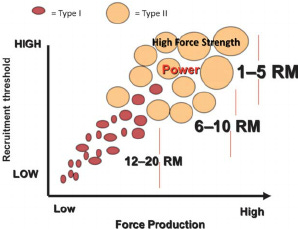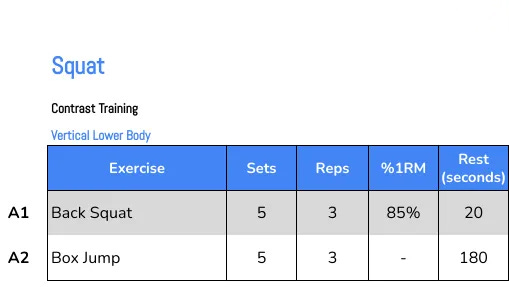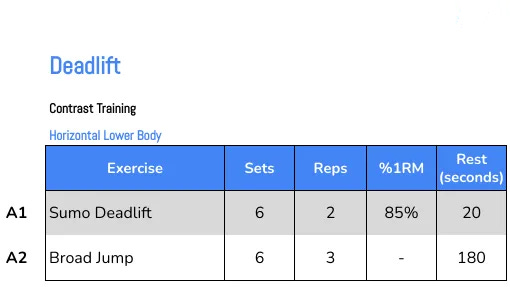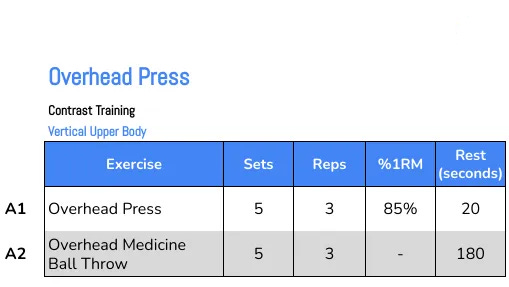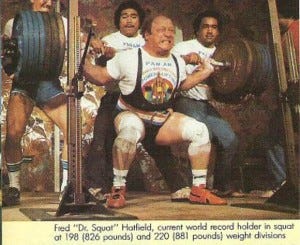Contrast training allows you to lift heavy, jump higher, and run faster so you can build strength and athleticism concurrently. Big muscles are cool. Big, strong, and powerful muscles are cooler. Don’t be all show and no go. Contrast training is a great way for athletes, and regular gym-goers who want to be more athletic, to develop their capacity to generate more force.
Contrast training involves a superset of a heavy lift with a plyometric/power exercise. This method was common in eastern block sports training and you still see frequent use of contrast training in strength & conditioning programs.
How It Works
Increased Motor Unit Recruitment
Increased Neuromuscular Excitation & Coordination
Increase Rate of Force Development
There are immediate potentiation benefits to pairing a plyometric with a heavy lift. You could either order the plyometric first and then lift something heavy, or do the opposite (lift heavy first and then jump) depending which movement you want to potentiate.
A jump before a heavy squat for example will charge up the nervous system to produce more force for the squat reps. A heavy squat before jumping will also typically allow you to jump higher. These benefits can be explained with post activation potentiation (PAP).
Typically PAP is done with a heavy movement followed by an explosive movement and will involve more rest. For instance, you’d hit a heavy 1-3 reps on the squat, rest 3-5 minutes, then jump.
Complex training, or contrast training, is the opposite. You’ll do an explosive movement then hit something heavy. If you’re jumping first you can get away with shorter rest intervals since it’s less fatiguing on the muscular system than a heavy squat.
The first movement acts to increase motor unit recruitment so you can recruit more type 2 muscle fibers. By pairing two similar movements (a box jump and a squat for example) we can also improve neuromuscular coordination that carries over to the performance of the second movement.
Force of the working muscles is increased by the previous contractions that recruited high threshold motor units. The greater the force output, the more higher threshold motor units are recruited and the more type 2 muscle fibers are tapped.
“…the contractile history of a muscle influences the mechanical performance of subsequent muscle contractions.”
Postactivation Potentiation: An Introduction
This article isn’t about hypertrophy specifically, but you also see increases in motor unit recruitment the closer you get to failure in a set. For the record, you should not be going to failure or doing high reps for contrast training.
Contrast training simulates a similar effect of more muscles being recruited to produce more force, just without the metabolic accumulation you would see from something like a 12 rep set to failure.
Contrast training should not be used for conditioning.
A mistake people often make is putting plyometrics or sprints into their training as conditioning when they should be used for training speed and power instead. You want to make sure your efforts are maximal for plyometrics. This means getting sufficient rest and keeping your heavy lifts typically under 3 repetitions. If your goal is strength endurance, then you can do 3-6 reps for the heavy set and more plyometrics (>3 reps).
How to Do Contrast Training
Pair Two Similar Movements
The movement mechanics should match up closely for the best transfer.
Squats & Vertical Jump Variations (box jumps, vertical jumps, etc.)
Deadlifts & Kettlebell swings / Broad Jumps / Bound Variations
Bench Press & Plyo Pushup Variations / Medicine Ball Throws
Step 1: Get a Need For Speed (High Velocity, High Power)
Perform 2-5 reps of a high velocity / plyometric movement
Step 2: Recover for 15-30 seconds
This is almost like a rest pause interval. PAP studies will have multiple minutes of rest between movements but that’s not entirely necessary if you’re doing the plyometric first to prime the heavy lift. 15-30 seconds is enough time to keep training efficient and to replenish the ATP-PC system sufficiently for high outputs.
If you’re out of shape you may need to rest longer. This is entirely dependent on your output. If reps start to suffer or slow down, you should rest longer.
Step 3: Lift Heavy (1-5 Reps)
If your goal is maximal strength then shoot closer to heavy singles, if your goal is continued force output, shoot closer to the top of the range.
When selecting a weight, make sure you’re staying shy of failure. Keep 1-3 reps in the tank (with good form) at all times.
Use a load > 80% of your 1RM. Start in the range of 80-90% for 1-3 reps and adjust from there as needed. Keep RPE between 7-8 for most sets. No grinding reps.
You could also use an overcoming isometric instead of a lift. I’d recommend a 3-5 second isometric hold at MAX intensity. The longer the hold, the less it becomes about strength and more it turns into endurance.
Step 4: Rest 3-5 Minutes
“This is too long bro.” No. If your goal is to produce maximal strength and power then you need maximal efforts each set. That’s only going to happen with sufficient rest. Again, we shouldn’t be using this method for conditioning.
Perform 3-6 Total Sets
Depending on priority. If speed and power is a focus of your training then go closer to 6 sets and perform less accessories. If however you need to put more attention to training other qualities, then go closer to 3 sets. Whatever you choose, make sure to manage your volume. You don’t need to be doing a ton of plyometrics and then ripping 20 more sets of leg exercises.
Contrast Sets Examples
Squat Contrast
Deadlift Contrast
Bench Press Contrast
Overhead Contrast
Considerations
This should go without saying, but for the love of all things holy….warm up.
I have so many clients starting out that don’t like to warmup properly and will just throw weight on the bar. Increase circulation with some movement and mobility drills if needed, then take atleast 3-5 warmup sets with the strength movement you selected.
Make sure your joints are ready for impact. If your knees can’t handle jumping down from a box then this isn’t a method I would recommend. Alternatively, you could do something like a heavy squat followed by a speed squat with lighter weight until your joints begin to feel good enough to resume plyometrics.
Lift with compensatory acceleration (CAT) each rep. Including the warmup! Put as much force as you possibly can into the lift you’re performing. If you truly want a transfer of your force development capabilties this is super important.
If you don’t have experience training speed or power then this method can be greatly beneficial for improving your strength. If you’re doing contrast training for the first time I recommend trying a 4-6 week cycle before rotating exercises.
Stay Strong.
Questions? Drop a comment.
References
https://www.ncbi.nlm.nih.gov/pmc/articles/PMC3164001/#:~:text=Originally%20defined%20by%20Robbins%2C8,performance%20of%20subsequent%20muscle%20contractions.
https://www.researchgate.net/figure/The-size-principle-is-depicted-in-this-figure-in-which-each-circle-represents-a-motor_fig2_271953774
Bonus below.
Power Protocol
This is a recommendation I give for anybody starting off with plyometrics or power training. If you want to see a basic progression become a subscriber or do the free trial.
Keep reading with a 7-day free trial
Subscribe to Weekly Flex to keep reading this post and get 7 days of free access to the full post archives.






